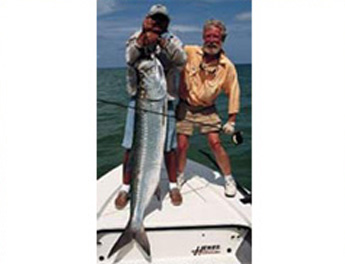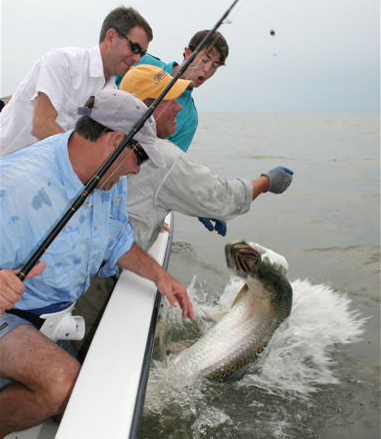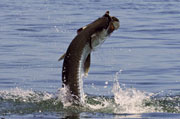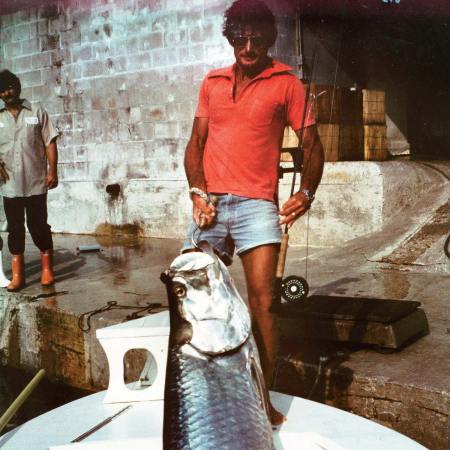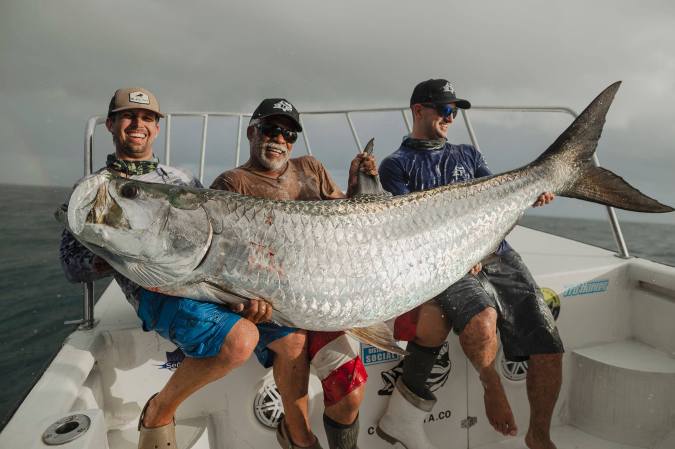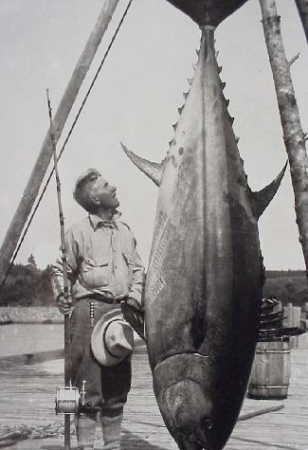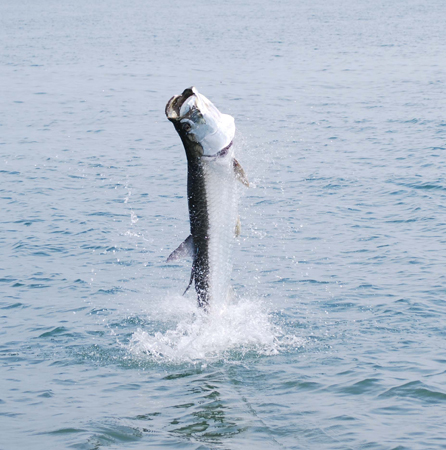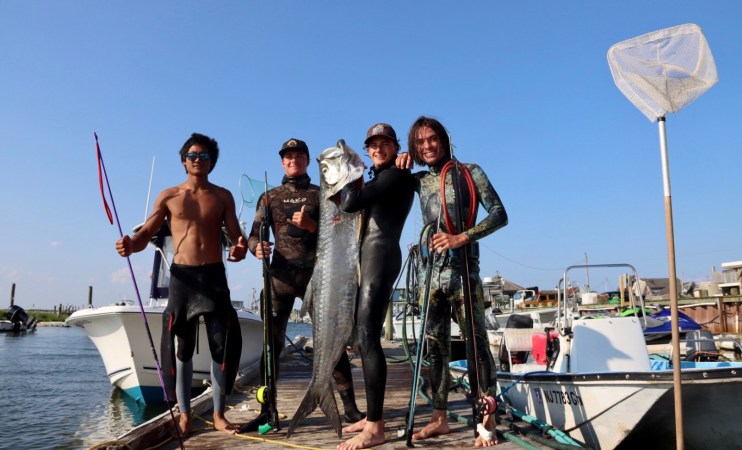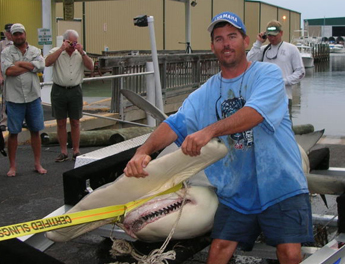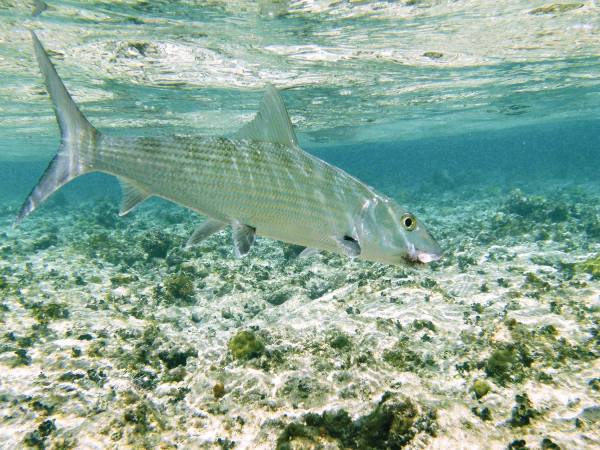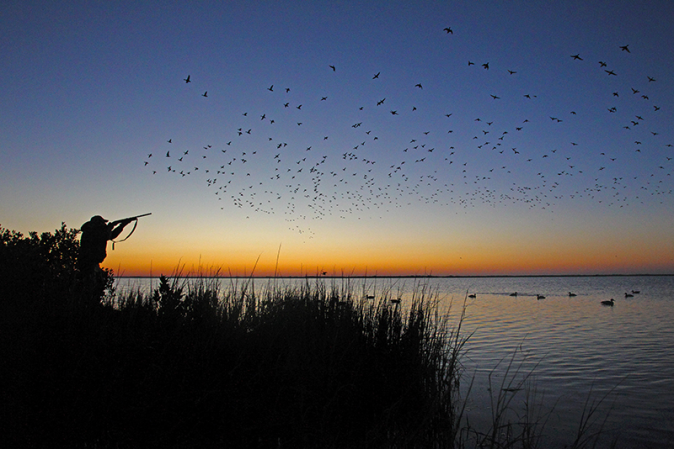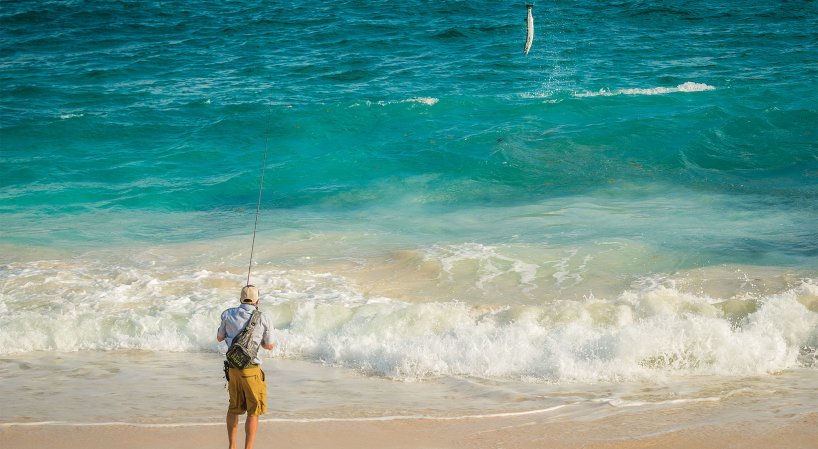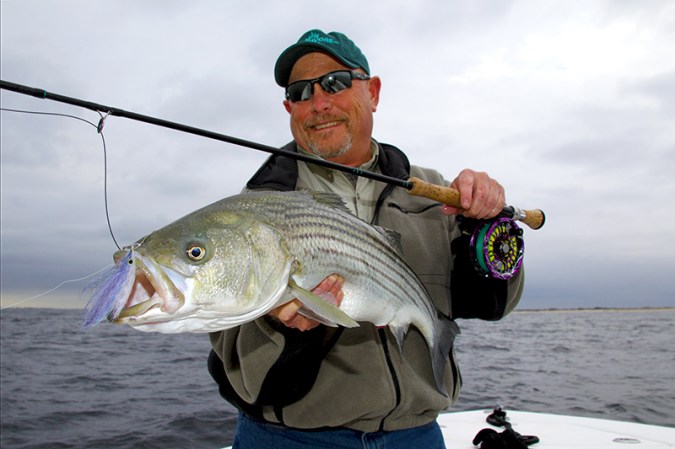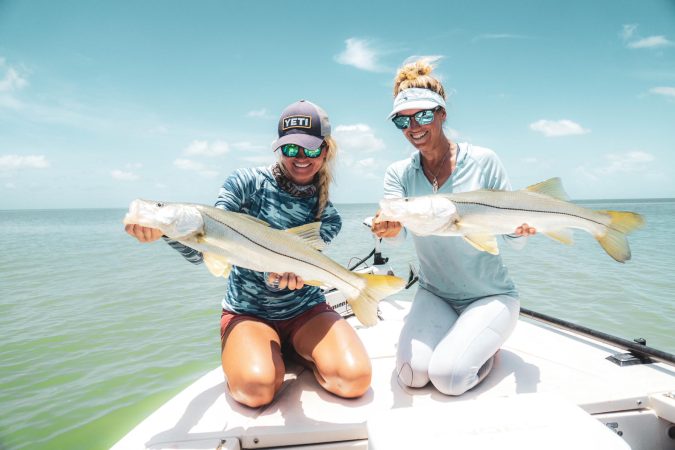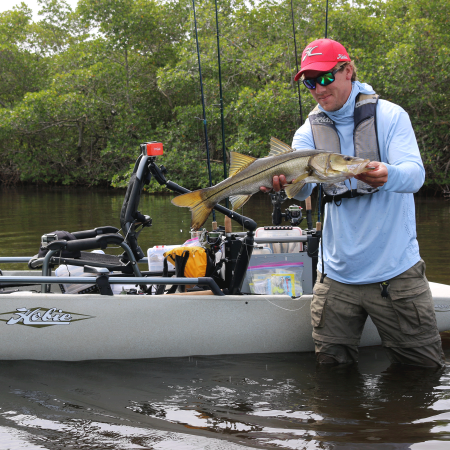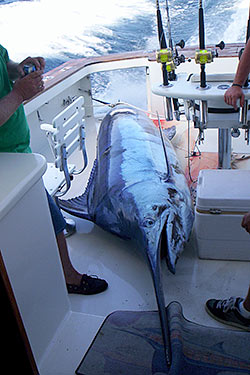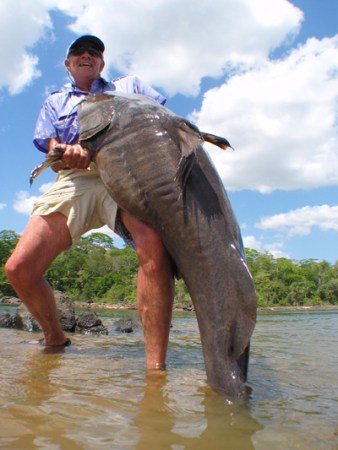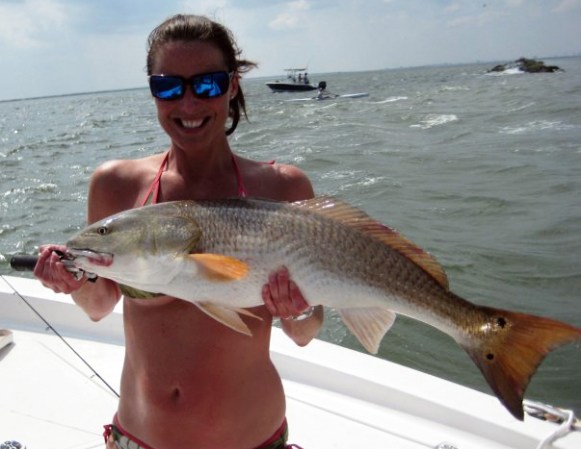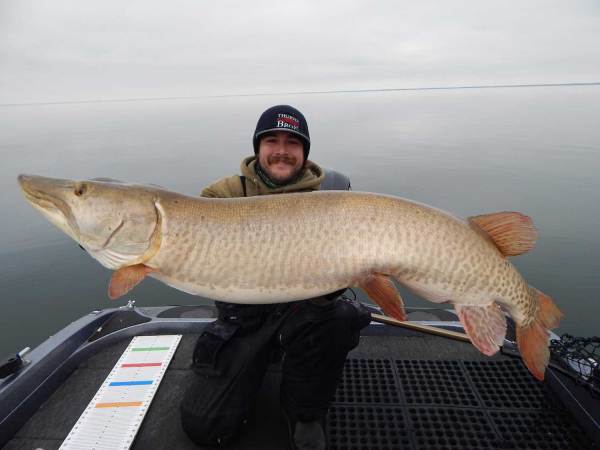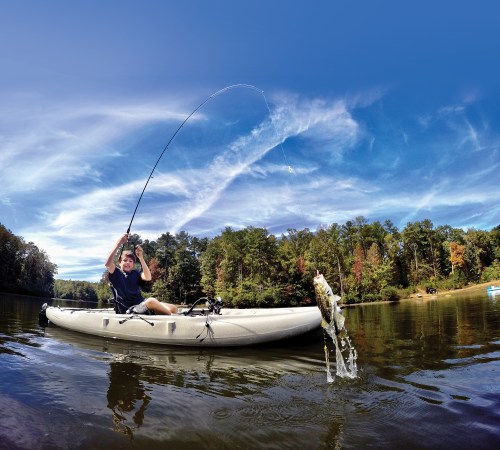Some years ago, I was standing on a pier watching the Florida sun melt into the water at day’s end, sipping a well-earned sundowner. To the north the sky was darkening into storm indigo, probably the same color as the bruises I knew were building on my stomach. My gut still ached from a pummeling rod butt, my hands were sore, my fingers were cut, my arms and shoulders were throbbing and my legs were stiff. And I was as happy as I ever remembered being. I forget how many fish jumped that day, but it was one of those times that change you forever, for better or worse. I promised myself then that as long as I was physically able I’d keep chasing the saucer-eyed silver creatures.
I am possessed by tarpon. There are those who argue that tarpon fishing is essentially a contact sport, all flash and crash. They say it is neither as cerebral as trout fishing nor as sustaining as Atlantic salmon angling, and that it lacks the subtle intensity that wading for bonefish entails.
There’s no denying the physical aspects of the game and its pyrotechnics, both of which are parts of its allure. But I’ll tell you, tarpon can be as difficult as jaded, midge-sipping trout in a slick spring creek. They’ve also developed a cult following, with trappings, tackle and tall tales every bit as complex as those of salmon angling. Tarpon hunting is not a genteel endeavor. Tarpon hunting is war.
Consider the many presentations involved in the pursuit: live-baiting, trolling, deep jigging, plugging with tackle that could stand in as a heavy largemouth bass outfit (if your reel holds enough line) and flyfishing. Every time out, I’ll choose the bait-casting outfit or, if conditions permit, fly tackle. I’m after the challenge of achieving the perfect presentation — the cast and retrieve that ignites the violence. I want the strike, the electric response that follows and all the jumps the fish will give. It is not even important that the hook stay in until I hold a beaten tarpon at boat side for release. The first time I hooked into a tarpon the sheer rush of power was terrifying, akin to when, as a kid, I took the drop in the front seat of a roller coaster for the first time. Your initial thought is, “My God, what have I done?” But even before those things comes the hunt.
** Once Hooked, There’s No Going Back **
The tarpon fishing I love is from a low-slung skiff in clear, jade-tinted water, the boat slowly poled along multicolored banks of living organisms, through channels, over basins, under a burning sun. After a spell, you enter a trance-like state, a feeling of birdlike suspension over another world. Then, when you see the dark wavering forms of four or six or perhaps a school nearing a hundred fish, you come alive in a way few moments can duplicate. It is pure exhilaration, like reaching the high timber edge and finding the six-point bull is still there, in the open, head turned toward you, with the wind right. When distant tarpon begin closing, you have only moments to gather yourself and compute mentally the direction and force of the wind, the boat movement, the tidal flow, how the fish’s track will affect your cast and what will happen to your lure in the water.
Once, off Big Pine Key in Florida, I was sure I had it right and had figured in all the factors. But I’d left out one vital element. I was fishing with a high-intensity guide we’ll call Captain Sensitive, and when the fish angled in I remembered his warnings. My cast was away, the fly shooting perfectly at the lead fish despite the tricky crosswind.
Incredibly, however, it landed over her back.
“The boat — the boat’s moving! @#$!!&!” advised Captain Sensitive in a roar that might have been heard all the way to Key West. And of course it was, drifting in the current toward the fish. I forgot to allow for it, but never mind. Amazingly, the school did not spook and one of the big female tarp’s consorts eased up, opened its maw and gulped.
“Hit him, hit him!” Captain Sensitive screeched at me, caught up in the moment of engagement with the tarpon and nearly apoplectic.
It wasn’t necessary. I already had set the hook, despite twitching like a hound having a nightmare. The game ended well, but I never forgot the lesson. Still, it took me some seasons to stop my knees from shaking at such moments.
From there, the grip only tightens. I don’t live in tarpon country, yet I hunt these fish each year. Every trip is fresh, and though I know tarpon better now, each time I meet them my heart thumps like a basketball on hardwood. Among those I know who are able to saturate themselves with the sport, there seems no waning of enthusiasm, no softening of intensity. It seems impossible to quit these fish despite what they can do to you, which is plenty. Some individual tarpon are stronger, but even a less determined fish will sweat you, leaving you panting and muscle-worn by the time it comes to hand. Tarpon can also break your tackle while you fight them or when they fall into your boat — which they do both hooked and not. In a boat, or flying into it, a big tarpon can also break your bones.
If you have some skill and are determined to catch tarpon the most difficult way — either with light tackle or a fly rod — it’s time to make your move. But do not delude yourself; were you born knowing how to drive a Formula One race car? My first advice is that you should learn something of the strength of these fish by casting with stout tackle or by trolling or live-baiting. The evening fishing that is normally going well in April along the Florida Keys bridges is an excellent place to learn. My daughter-in-law Jackie hooked her first big tarpon here with Captain Danny Strub aboard the Mean Marlene II off Marathon. She hadn’t really thought about the size of tarpon until she saw Danny hook for bait a live mullet the size of a small bonefish. Then she whispered to my son Greg, “My God, how big are these fish?” Within 10 minutes, she learned.
One crashed a bait near the surface, sucking a howitzer-sized crater in the silky water and sending up a shower. Two heartbeats later the tarpon leaped. It was framed by the old bridge passage in the low golden light and we hollered like savages. Greg freed us from anchor while Captain Danny cleared lines. The fish headed toward Cuba.
Finally, 21/2 hours later, with the sun long set and the only illumination a spotlight, Danny lip-gaffed the fish. Quick measurements put it at a good 150 pounds. The next day, but not that night, Jackie said she was ready to fight one again.
** Breaks of the Game**
Recently, off Daytona, two anglers trying to gaff a “green” tarpon quickly bailed from their skiff when the fish leaped in. The tarpon beat against the hull, and the boat, mainly held together by its seats, soon came apart. These fishermen could wade ashore. That wasn’t an option for the husband and wife off Key West who left their little craft when a medium-sized 60-pounder came aboard. The tarpon knocked the sides out of the boat. The couple made shore swimming through serious shark water.
Such tarpon behavior isn’t confined to the Florida Keys. On one Costa Rican adventure, friend Jim Chapralis had three fish leap into his boat. Mainly, the damage they inflicted was to the tackle. Jerry Tricomi, former owner of Parismina Tarpon Rancho on the Parismina River, wasn’t as lucky. Once, while fishing the boca with his daughter, a huge fish crashed into the cockpit of his johnboat and destroyed several rods. In an effort to protect his daughter, Tricomi jumped between the fish and the girl and was impaled by one of the trebles of the plug still in the tarpon’s mouth. The hook went in and around his Achilles tendon, extending it like a stretched bungee as the fish continued to thrash. Eventually Tricomi cut the line and manhandled the fish out of the small craft.
Tarpon have come aboard their share of large boats, too. “Coon” Sweat, who developed the Coon Pop jig, an effective lure in waters of the Mississippi River Delta out of Venice, La., had a tarpon drop into his cabin cruiser and writhe into an upright position. “You expect them to lie flat and start slamming,” says Coon. “This one started ‘swimming.’ She knocked off scales and left a layer of slime inches deep. We were dancing on the seats. Finally two of us tackled her and scooped her out.”
It was a hooked backcountry fish that nearly cleaned my clock years ago in a bizarre circus-like chain of events that swung from slapstick to deadly serious. About to head in, we’d stacked rods in the port-stern corner of the big old cruiser that was used mostly for bottom-fishing in the Gulf and set up poorly for anything else. I took a last cast with a clubby fiberglass fly rod, and one of those dark backwater tarpon ate the offering. It came up once, then headed for the mangroves, the line ripping the surface and sending up a little spray. We followed in the old tub while the fish swapped ends in several course changes along the ragged shore. Closer still, I was sure the thing would jump and maybe go into the overhanging vegetation, but it didn’t.
Now we were really close, the fish between us and the mangroves. Then the mosquitoes came in a cloud and hit every square inch of our exposed skin, covering us like dark fur. Instead of tending the boat, the skipper ducked into the cabin for a can of bug spray. Yelling and dancing, he began spraying himself while I sprayed a string of expletives for him to get up and grab the wheel. He stumbled up, still spraying, arms and face dripping blood from mashed mosquitoes while I held onto the tarpon doing my own little dance, refusing to look at my arms, which, like the rest of my body, were on fire from the bugs. He grabbed the wheel and turned the boat but it was too late.
The fish broke for open water and we were in its path. It sailed out of the water, landed on the wide gunwale, lay balanced on it for a heartbeat and then fell into the cockpit. I spun away as all hell broke loose. The fish hit the stacked rods, scattering and splintering them like glass straws as it squirmed and convulsed. Then it managed to make it up and over the stern and back into the water scot-free. One treble from a large plug was buried in the top of my boat shoe. We were both shaken by the near-disaster.
Boat-side Battery
Exciting moments occur when a tarpon is gaffed at the boat. Short-handled release gaffs are one thing: A lip-gaffed fish quickly pinned to the boat will thrash, but usually a strong person can hold on. Two-handed kill gaffs are something else. Few tarpon fall to the kill gaff any more, save for occasional recoi cut the line and manhandled the fish out of the small craft.
Tarpon have come aboard their share of large boats, too. “Coon” Sweat, who developed the Coon Pop jig, an effective lure in waters of the Mississippi River Delta out of Venice, La., had a tarpon drop into his cabin cruiser and writhe into an upright position. “You expect them to lie flat and start slamming,” says Coon. “This one started ‘swimming.’ She knocked off scales and left a layer of slime inches deep. We were dancing on the seats. Finally two of us tackled her and scooped her out.”
It was a hooked backcountry fish that nearly cleaned my clock years ago in a bizarre circus-like chain of events that swung from slapstick to deadly serious. About to head in, we’d stacked rods in the port-stern corner of the big old cruiser that was used mostly for bottom-fishing in the Gulf and set up poorly for anything else. I took a last cast with a clubby fiberglass fly rod, and one of those dark backwater tarpon ate the offering. It came up once, then headed for the mangroves, the line ripping the surface and sending up a little spray. We followed in the old tub while the fish swapped ends in several course changes along the ragged shore. Closer still, I was sure the thing would jump and maybe go into the overhanging vegetation, but it didn’t.
Now we were really close, the fish between us and the mangroves. Then the mosquitoes came in a cloud and hit every square inch of our exposed skin, covering us like dark fur. Instead of tending the boat, the skipper ducked into the cabin for a can of bug spray. Yelling and dancing, he began spraying himself while I sprayed a string of expletives for him to get up and grab the wheel. He stumbled up, still spraying, arms and face dripping blood from mashed mosquitoes while I held onto the tarpon doing my own little dance, refusing to look at my arms, which, like the rest of my body, were on fire from the bugs. He grabbed the wheel and turned the boat but it was too late.
The fish broke for open water and we were in its path. It sailed out of the water, landed on the wide gunwale, lay balanced on it for a heartbeat and then fell into the cockpit. I spun away as all hell broke loose. The fish hit the stacked rods, scattering and splintering them like glass straws as it squirmed and convulsed. Then it managed to make it up and over the stern and back into the water scot-free. One treble from a large plug was buried in the top of my boat shoe. We were both shaken by the near-disaster.
Boat-side Battery
Exciting moments occur when a tarpon is gaffed at the boat. Short-handled release gaffs are one thing: A lip-gaffed fish quickly pinned to the boat will thrash, but usually a strong person can hold on. Two-handed kill gaffs are something else. Few tarpon fall to the kill gaff any more, save for occasional reco
